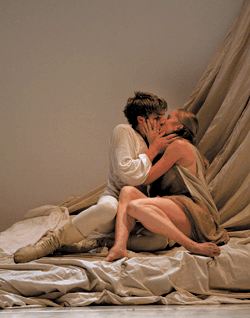Some ballets really are sacred cows—change a phrase in Sleeping Beauty or Swan Lake and you’ll be explaining yourself to the cognoscenti long after the performance is over. But danced versions of Romeo and Juliet are up for grabs. Most ballet companies in the U.S. have some version of the work in their repertories, but there really is no one “definitive” production.
When Peter Boal last year added Jean-Christophe Maillot’s Romèo et Juliette to Pacific Northwest Ballet’s repertory, they already had a different production in their vaults: Kent Stowell’s 1987 The Tragedy of Romeo and Juliet. It’s a lavishly handsome, traditional work, tailor-made for the company at that time, with elaborate sets by Ming Cho Lee. The Maillot version, dating to 1996, is about as far from Stowell’s as you can imagine. It removes about all you could remove and still be Shakespeare.
The sets by Ernest Pignon-Ernest are distilled to a handful of movable screens with delicate nature images projected on them. The streamlined costumes by Jérôme Kaplan have as many Asian as Italian references. Sergei Prokofiev’s score, written in the mid-’30s, is tinged by the modernism of that decade, free from soupy sentimentality. Maillot prunes the hubbub of big crowd scenes, further editing out several characters and minor plot points to concentrate on the story of love found and tragically lost.
Though the abridged show still runs two and a half hours, it feels like much less. Maillot gives the story a sense of continuous action that only stops when Friar Lawrence slowly crumples behind the two lovers lying on the floor.
This difference in tone between these two productions—stately versus austere—echoes other choices that Boal has made during his past four years as PNB’s artistic director. Boal was hired in part because of his credentials as an exponent of neoclassical ballet, especially the works of George Balanchine. And though he’s certainly continued that tradition here, his other additions to the repertory have been more unexpected.
And possibly more influential. While the ballet world waits for the next Balanchine to blaze a new path, Boal has proven more of a 21st-century multitasker.
When he talks about his vision for PNB, Boal often says he wants people to see how many different things ballet dancers can do. His list so far has included modern dance of all stripes (including, recently, Twyla Tharp), Broadway dancing, and even hip-hop. Rather than running a Balanchine specialty shop, he’s turning PNB into a nimble, versatile company that can quickly adapt to different genres.
For this reason, Maillot’s Roméo et Juliette, with its multiple references to modern dance, is particularly well suited to the deep, protean PNB ensemble. Last year, Noelani Pantastico was the only Juliette for the entire run, with injuries and visa troubles keeping other women offstage.
This year, Carla Körbes and Kaori Nakamura divide the plum role; both emphasize the character’s youth. (I’ve seen the two perform on different nights.) They’re almost like kids on a playground, all kicking legs and wheeling arms in the first scene with the Nurse. This makes Juliette’s transition to womanhood all the more vivid. But the character doesn’t leave all her girlish exuberance behind. (Körbes is particularly convincing as the tomboy, which colors Juliette’s almost prankish first duet with Roméo.)
Lucien Postlewaite’s Roméo is in love with love, a dreamy boy who on first sight of Juliette on her balcony literally drops his jacket. The Körbes-Postlewaite pairing feels youthful, playful, as fun as a prelude to tragedy can be.
Opposite Nakamura’s Juliette, James Moore’s Roméo is more aggressive, more of a guy. His transformation to peacemaker between clans, after he meets her, becomes quite poignant. We hold our breath and hope for his success. For her part, Nakamura reads as a bit more knowing, more aware of the world she enters at the ball. Their partnership seems more adult.
So which pairing should you see? If you can stand the double dose of heartache, I’d say both.








